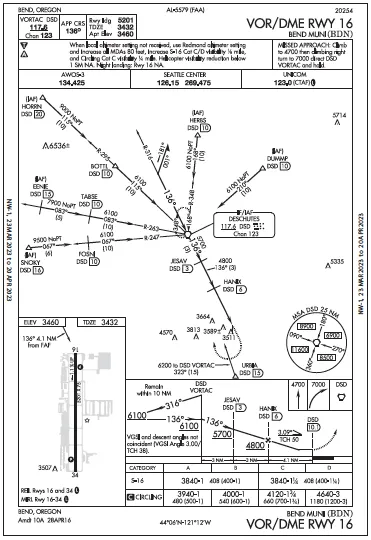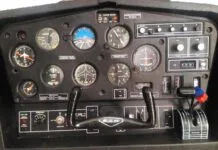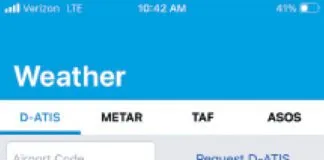Alternate Mins NA?
As the FAA is transitioning the National Airspace System (NAS) to Performance Based Navigation (PBN), more and more we see VORs becoming unmonitored or unserviceable. When a VOR is NOTAMed “unmonitored,” my understanding is that if you can identify it in the aircraft (Morse code) and have a good signal, you can use it. Where it becomes an issue is in preflight IFR planning—you cannot use an IAP that is based on the unmonitored VOR as an alternative for flight planning (although I could not find an AIM or FAR reference…).
!FDC 3/1744 BDN IAP BEND MUNI, BEND, OR. VOR/DME RWY 16, AMDT 10A… ALTERNATE MINIMUMS NA EXCEPT FOR ACFT EQUIPPED WITH SUITABLE RNAV SYSTEM WITH GPS, DSD VORTAC UNMONITORED. 2301061525-2302071525EST
But the NOTAM above does not make sense as it says alternate minimums NA except if you have an IFR GPS. But how would a GPS help if you rely on that VOR-based IAP to land and get there to find the VOR is down. In this case there is an RNAV Y 16 IAP. Perhaps that’s what you should use? But I would have thought in that case, just make the VOR-based IAP NA for alternate planning and force pilots to only use the RNAV IAP for alternate planning?
A final thought, DSD VOR is part of the “back-up plan” minimum operational network of VORs. I am surprised a MON VOR can be left unmonitored for so long. I had to call our local tower to report the VOR was down recently.
Jay Bunning
Bend, Oregon
The FAA allows GPS to substitute for VOR. So, the NOTAM you provided seems reasonable: The VOR is unmonitored, so there’s no way to know if it’s available. Thus, since the operational status of the VOR is unknown, using that VOR approach as an alternate is restricted unless you can use GPS in lieu of the VOR. This is standalone and has nothing to do with the existence of the RNAV Y 16 approach.
As for why the FAA would allow an unmonitored VOR to serve in the MON is beyond us. But, we’d guess it might have to do with the speed at which the FAA wheels grind.
Give ’Em a Ride
It was a sunny, cold February day in the Pacific Northwest with clear skies. During my flight out of our busy Class-D airspace, I heard a pilot identify themselves as a student pilot and query the tower controller if a low reading on the ammeter is an issue for continuing with their flight. The tower controller responded politely but firmly: “I’m not a pilot, I’m a controller, I don’t know.”
This served as a good reminder that air traffic controllers are usually not pilots by trade. There might be the occasional exceptions, such as Elim and Tarrance who write the excellent ATC articles in IFR, but it’s definitely not the norm.
The next time you visit your local tower, offer to take the controllers up for a lap in the pattern or the local area. While that might not teach them what to do with a low ammeter, they will get a much better picture on the unique challenges while flying an aircraft in a busy airspace. We as pilots rely on ATC, and they rely on us to comply with their instructions to keep everything safe, so let’s help each other out.
Oliver Huebler
Bellevue, Washington
Excellent suggestion, Oliver, and thanks for making it.
Approach Good; Rollout Bad
I am looking for clarification or some education perhaps. An article you ran years ago, “Tame the Fog Monster,” mentions “landing in the clear, but rolling out into zero-zero” yet the following explanation remains foggy. There is a discussion about reported visibility, I suspect while flying VFR, without mention of flight visibility which I thought was controlling.
The real question, however, is if a field is reporting below minimum visibility while on an IFR flight plan, Part 91, cleared for an approach, and you can see the requisite runway environment, including the threshold, before the MAP. At least half of the runway is in fog, however. Can you legally land where you can see the runway, and roll out into the fog? For the purposes of greater assurance if the runway is clear, we can assume this is at a towered field.
Dustin Petersen
[Location withheld from e-mail]
We’re not aware of any place your hypothetical situation is directly covered in the regulations. Landing is covered by §91.175, of course, but no mention is made of any visibility requirement other than for landing. This is somewhat covered for commercial operations as their visibility minimums are often stated in RVR for touchdown, midpoint, and rollout.
But, just because there’s no explicit prohibition from landing legally then rolling out into zero-zero, doesn’t mean it’s a good idea. Plus, if anything happens in the zero-zero rollout, you can be confident of a violation of the catchall §91.13 – Careless or reckless operation.
Reduce Runway Incursions
I am an IFR magazine subscriber and with the recent runway incursions, I would like to bring to your attention what we have developed over the last few years:
We have created a system, the Runway Incursion Prevention System (RIPS), that would control hardware displays on an airport at each taxiway and runway intersection to give progressive taxi instructions, hold short, cross Runway xx, etc. to aircraft and ground vehicles via voice recognition software of ground and tower controllers’ instructions.
A touch screen monitor in the tower would also display the aircraft and its route as it taxied past each display on the field. These displays would identify the aircraft and display progressive taxi instructions, i.e.. N123AB: LEFT ON CHARLIE, N234XY: CROSS RUNWAY 18, DL123: HEAVY HOLD SHORT RUNWAY 27.
Any display that wasn’t showing progressive taxi instructions would display: STOP. CONTACT GROUND 121.9. Incorrect, inaccurate or conflicting taxi instructions would immediately be identified and flagged for the controller to correct. By monitoring and analyzing controller instructions and displaying progressive taxi instructions at every intersection, RIPS would substantially reduce runway incursions at every airport where it is implemented.
RIPS addresses the needs for pilot and ground vehicle situational awareness and the elimination of controller / pilot / ground vehicle miscommunication on the ground. RIPS does not require any equipment to be added to an aircraft or vehicle. RIPS would provide pilots and ground vehicles with “Heads Up” progressive taxi instructions, hold-short instructions and runway crossings. It will eliminate controller / pilot miscommunication and is extremely visible during daylight hours, during snow conditions when other runway markings are not visible, and when visibility poses a threat to safe and efficient operations: at night and during low visibility.
As of yet we have been unable to get this in front of the FAA for review. Any help would be greatly appreciated.
Robert Ash
Shelby Township, Michigan
First, we have no inside track to the FAA, so we’re unable to provide any inroads for your proposed presentation.
That said, we do know that the FAA can be rather insular regarding new technology, preferring instead designs and paths that have been conceived in house and put out to bid for development by established federal contractors.
Also, they’re extremely reluctant to even consider anything that might increase controller or pilot workload at all. Your description to me suggests there might be an increase to controller workload, even if there isn’t. So, in any attempt to pitch this to the FAA, we suggest that you emphasize that there is no controller workload increase.





